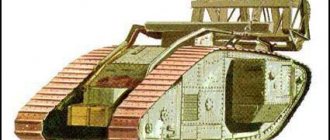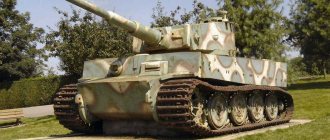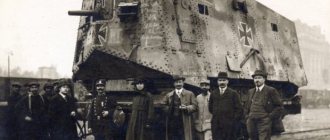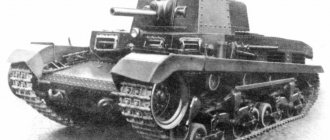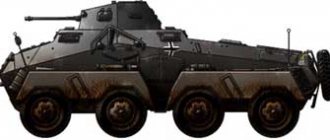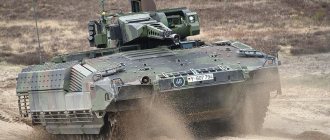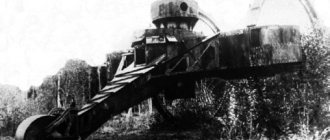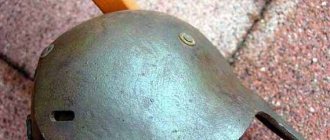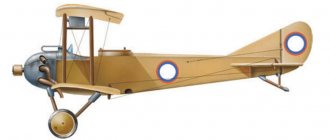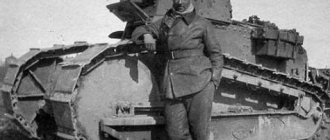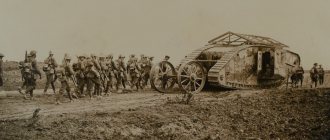Heavy tank MK. I (UK)
Tank Mk. I
The huge losses suffered by the Allied ground armies on the battlefields of the First World War forced the British military to seriously address the issue of building self-propelled “armored forts” - tracked combat vehicles capable of moving over rough terrain and overcoming trenches, scarps, ditches, and wire fences.
The result of the hard work was the official testing of the vehicle, which took place on February 12, 1916, which was called “Big Willie” and was put into service under the Mk brand. I. The world's first tanks were produced in two versions - with cannon and machine gun armament. The cannons were called “males” and were armed with two cannons mounted in the side sponsons and four machine guns. Pure machine gun tanks, or "females", were armed with six machine guns. A total of 150 cars were produced: 75 “males” and “females”. Later, after the battle of Villers-Bretonneux, which took place on April 24, 1918 and revealed the complete helplessness of the “females” in battle with enemy tanks, on these vehicles one machine-gun sponson began to be replaced with a cannon one.
The thickness of the armor of the Mk. I could not protect the crew not only from artillery fire, but also from armor-piercing bullets. Another very significant drawback was that the fuel to the gasoline engine was supplied by gravity, so often at the most crucial moment, when the combat vehicle, overcoming an obstacle, raised its nose upward, the engine stalled due to a cutoff in fuel supply. The speed of the tank on the off-road did not exceed 2 km/h, and this often defeated the advance of the infantry. The four people operating the tank - the driver, the commander and two transmission workers - required coordinated actions and considerable physical effort. To overcome the wide ditches and trenches on the roof of the Mk, I, it was necessary to carry fascines, which were dropped into the ditch in front of the tank.
A pair of wheels mounted behind the tank served for course correction and large-radius turns. It was believed that they helped overcome wide ditches, but due to their bulkiness and vulnerability they were soon abandoned
The crew's working conditions were very difficult due to high temperature, shaking and gas pollution, since there was simply no ventilation. The situation with communications was also unimportant: long-distance communication using carrier pigeons was extremely unreliable, and short-range communication was carried out using signals with flags or semaphore, but in the smoke of battle it was not always possible to see the leading tank through narrow cracks.
In short, the Mk. I were far from perfect even by the standards of their time. Their numerous shortcomings were already evident in the first battle of the Somme on September 15, 1916, when out of 49 tanks that the British had, only 32 managed to reach their original positions. The rest got stuck in the mud or failed due to breakdowns. But that’s not all - of the remaining vehicles, only 18 were able to take part in the battle: 5 got stuck in a swamp, and another 9 had various mechanisms fail.
However, even despite the small number of tanks, their technical imperfections, difficult terrain and poor interaction with infantry, the British advanced 5 km in the Battle of the Somme, and the losses in manpower were 20 times less than usual. And although the hopes placed on the tanks were not justified - it was not possible to break through the front - the success achieved made it possible to evaluate the considerable prospects of the new military equipment.
The debut of tanks on the battlefield is the British Mk. I, in the pre-dawn darkness, go on the attack at the Somme on June 24, 1916.
Despite the serious shortcomings of the first English tank Mk I, British tank builders did not abandon the technical solutions incorporated in it. Over the entire period of the war, they made only very minor improvements to the design of the tank.
Heavy tanks MK. IV and MK. V (UK)
Tank Mk. V
A pair of captured Mk. IV, which belonged to the Red Army. These vehicles, called "Ricardo", took part in battles during the Russian Civil War. A small number of them were used in the Red Army until 1930.
The first experience of combat use of Mk. I revealed a number of significant shortcomings in them that required immediate elimination. At the beginning of 1917, tanks of modifications Mk. II and Mk. III (50 of them were built), differing from their predecessor only in the absence of tail wheels and anti-grenade nets on the roof, a slightly improved design of hatches and viewing slots, as well as slightly reinforced armor. However, the appearance of modifications Mk. II and Mk. III did not eliminate all the problems, and it was decided to continue the modernization of combat vehicles of this type.
On vehicles of the following modification - Mk. IV, the order for which was issued in September 1916, immediately after the Battle of the Somme, the reservation was further strengthened (the thickness of the frontal armor reached 16 mm, the side armor - 12 mm, the roof - 8 mm), the sponsons were made retractable to facilitate transportation, and the guns shortened (from 40 to 23 calibers). Now, when the tank overcame obstacles, they did not stick to the ground and did not cling to trees and walls of houses. The fuel tanks were moved outside - into the compartment between the rear branches of the tracks, which, by the way, became wider in order to increase maneuverability. But more importantly, fuel began to be supplied to the engine forcibly. As a result of all these changes to the design, the combat characteristics of the tank significantly increased and the Mk. It was no coincidence that the IV became the most popular British tank. From April to December 1917, about 1,200 of them were produced.
Attack of a pair of British tanks Mk. V. During the First World War, there was no specialized anti-tank artillery that would effectively counter tanks. Therefore, tanks often went on the attack, as they say, “in herds”
Tank Mk. V, which replaced the Mk. IV in December 1917, was a further development of the line of British heavy tanks. True, this time the changes made, although not very noticeable in appearance, were more significant: a four-speed planetary Wilson gearbox was installed on the tank, thanks to which the vehicle could now be driven by one person, and a special Ricardo tank engine. The first tanks of this type began to enter service with the troops in May 1918, and a total of 400 vehicles were produced before the end of the war - 200 males and 200 females each.
Another modification was the Mk. V* (with star), extended by inserting a two-meter section into a Mk. body cut in half. IV or Mk. V. Without losing longitudinal rigidity, the vehicle acquired the ability to overcome wider ditches and craters. At the same time, it was possible to improve the grip of the tracks and the ground and increase the internal volume, now sufficient to transport additional equipment or 25 infantrymen. The first attempt to use the new capabilities of the tank and land troops was made on August 8, 1918 near Amiens and ended in failure - due to poor ventilation, the soldiers simply died from exhaust fumes.
Commander's cabin on the Mk. V was increased, and the design of the driver's viewing device provided more effective protection against lead splashes when hit by bullets
A total of 579 tanks were converted into the extended version.
Tanks Mk. IV and Mk. V became the main British tanks of the First World War. Despite their shortcomings, they performed well in many battles and were widely used not only by the British army, but also by their allies - the French and Americans. Captured Mk. IV fought in the Kaiser's army, and Mk. V, which were part of the interventionist and White Guard troops, took part in the battles of the civil war in Russia. A small number of them were captured by the Red Army, and subsequently under the name "Ricardo" they were used in the Red Army until 1930. In the UK the Mk. V and Mk. V* after the end of the First World War were in service for only a few years. Single copies of Mk. V were available in the Armed Forces of Latvia, Estonia, Poland and Japan. Several tanks that the Red Army received after Estonia joined the USSR were even used in the defense of Tallinn in August 1941.
Tanks in the First World War
We want to recall the most interesting aspects of the use of tanks in the First World War. The article is based on materials from Soviet military periodicals dedicated to armored forces, special works of military specialists, as well as materials from the Great War era.
A new weapon and the first impression of it from the inside.
Caricatures on the tank theme immediately after the appearance of armored monsters
Combat debut
So, the debut of British tanks on the fields of the First World War took place on September 15, 1916 on the Somme - near Fleury, south of Bapaume. Of the total number of 49 assigned for the first tank attack in history, 17 vehicles did not arrive at the starting line due to malfunctions.
Tank of Company D on Rue Fleury, 15 September 1916.
The use of armored vehicles was conceived as follows: tanks, being moved in groups of 2 - 3 units against the strongest enemy strongholds, were supposed to reach German lines 5 minutes before the approach of their infantry. Of the 32 operational tanks, 14 remained on the battlefield. Despite the technical surprise achieved (the effect caused by the technical novelty of the appearance of new weapons), the success was local in nature. And this despite the fact that technical surprise was accompanied by tactical surprise - the arrival of tanks on the theater of operations remained shrouded in an impenetrable shroud of secrecy.
Mk-1 “female” after the battle at Fleury
In the campaigns of 1917 - 1918 tanks were actively used by the British and French - accompanying almost all more or less serious combat operations.
Arras and Flanders
So, at the beginning of the spring battle of Arras, on April 9, 1917, the German 6th Army, after a brief but very strong artillery preparation, suffered a heavy blow - on both sides of the Scarpe. The tank attack disabled several German divisions - and the British penetrated all the way to artillery positions, winning about 6 km in depth on a 12-15 km front. But an operational breakthrough was not achieved.
In Flanders, with the help of tanks, the British also managed to bend the German front at a number of points. The tanks were to be followed by cavalry divisions. The more modest result was influenced by the transformation of the plan - towards reducing the scale of development of the proposed operation. But even in this case, in addition to the loss of space 2–4 km deep, the German 4th Army suffered heavy losses in prisoners and military equipment.
Mk-4 in the mud of Flanders, September 1917
Tanks at the Massacre of Nivelles and the Chemin des Dames
French tanks of the Schneider system first appeared on the battlefield on April 16, 1917 on the river. En - after 10 days of artillery preparation during the Battle of Kraon. Since the German trenches were too wide for this type of tank, it was decided to move forward first the infantry (which captured the first two enemy lines), and then the tanks were brought in with the help of work teams. In this case, the task of the tanks is to support the infantry during the attack on the 3rd line.
Schneider SA-1
In total, 82 tanks, built in columns, moved towards Juvencourt, located east of Craon. The armored vehicles had to travel a 3-4 kilometer distance in broad daylight, in full view of enemy artillery and in open areas. The infantry could not break through on their own beyond the 2nd line - and began to wait for the tanks. The tank columns managed to reach the 3rd line, and several tanks fought throughout the day - 2 - 2.5 km ahead of their tired infantry.
Schneider, destroyed on April 16, 1917 during the “Nivelle Massacre”
Then another 50 tanks were introduced - and the total number of vehicles involved reached 132 units. Of the 132 vehicles, 76 remained on the battlefield (including 57 units that were shot down by artillery fire; 25% of the crews were killed or wounded).
On October 23, 1917, tanks of the Schneider and Saint-Chamon types took part in the battle of Malmaison (Chmin des Dames) - after bad weather and 6 days of artillery preparation made the terrain difficult for them to pass. Of the 63 tanks sent into battle, only 21 actually went into action, facilitating the advance of the infantry. This time, the tank batteries were directly subordinate to the battalions (and the latter were followed by working teams to help the tanks overcome difficult-to-reach areas).
Saint-Chamond, bearing the proper name "Fantômas" and his crew
Historical Battle of Cambrai
And only then the so-called “tank” battle at Cambrai broke out. Under the cover of darkness and the vast forests of Havraincourt, the British amassed a strong tank force and a large number of cavalry over several nights - on November 20, 1917, they attacked the German position, which was poorly equipped in terms of artillery.
Due to the convenient terrain and complete surprise for the Germans, the tanks were a major success. We focus on the fact that the battle tanks were supported by a significant number of auxiliary vehicles, including communications tanks and tractors, and the artillery support of the operation differed in caliber.
British tank attack at Cambrai
The tank attack yielded a gain of space 8 km deep, 8,000 prisoners and 100 guns. With the loss of 107 tanks. The Battle of Cambrai proved the possibility of transforming a tank breakthrough from tactical to operational (all the necessary prerequisites for this were formed), the vital importance of the active interaction of tanks with cavalry and infantry, and the fact that with the help of tanks it is possible to break through a fortified enemy position without traditional long-term artillery preparation.
British tank crews with trophies
November 22 - 23, 1917, the Germans stop the tank attack - and through a counterattack, which was successful even without tanks, they neutralize the result of the British operation. During the counterattack, many tanks fell into German hands. In the battles near Bourlon and in the Bourlon Forest, there were cases of tanks being disabled by infantry - using hand grenades and other means. Even machine gun bullets with a steel core could also cope with tank armor. But the main enemy of armor was artillery fire.
The best weapons against tanks turned out to be the nerves, discipline and courage of people. They helped many brave soldiers climb onto enemy tanks or shoot them at point-blank range.
Lost time
Accordingly, the opinion of the German High Command about tanks was initially calm. The initial “fear of tanks” also subsided among the troops. Tanks were dangerous, but they were still disabled, and German attacks were successful even without tanks.
The decline of discipline and the weakening of the combat power of the German army in 1918 led to the fact that Allied tanks, used in large numbers under the cover of smoke screens, played a very important role in subsequent military events.
The Germans tried to answer the call, but time was lost. And when in the spring of 1918 the German troops advancing towards Amiens repeatedly used their heavy tanks, the small number of the latter nullified the entire effect of such use, excluding the possibility of any decisive action.
Duel between British and German tanks, April 24, 1918
At the end of May 1918, during the German offensive at Soissons-Reims, German troops showed their superiority over the French and British - and even numerous tanks did not help the latter.
Impact at Montdidier
On June 11, 1918, southeast of Mondidier, C. Mangin launched a counterattack - trying to delay the advance of O. von Gouthier on Compiegne. The counter attack was carried out with the support of 144 tanks operating on a front 12 km wide (and some tanks had to travel 10 - 14 km to the starting point of the attack). The infantry was to attack first, but with the support of tanks. The latter should, having caught up with the infantry, deliver the main blow. Since after this the infantry fell behind, the tanks continued the battle alone, being on average 1.5 km in front of the infantry - under fire from German field guns. The latter shot at tanks from a distance of 2 - 3 kilometers or less (small calibers - even from 1.8 thousand m).
Artillery support for the tanks was poorly provided, and tank losses were significant: almost half of the vehicles remained on the battlefield. But the result of their introduction into battle was that the German offensive in this area was stopped.
Soissons and Reims
Near Soissons, the German offensive was replaced by a stunning French counterattack on July 18, 1918, without any artillery preparation.
The French 10th and 6th armies under the command of Mangin and Degout were advancing towards Soissons-Chateau-Thierry-Reims. Thick masses of infantry went on the attack, supported by a number of tanks hitherto unprecedented for one sector. Renault's small and fast tanks proved themselves.
Renault FT moves to the forefront
Mangin had six groups of medium tanks (210 vehicles) on a 20-kilometer front and three battalions of Renault light tanks (45 each) in reserve. The groups were distributed among divisions and assigned to the corresponding units and formations.
And Reno's remains
Degut, on a 16-kilometer front, had one group of medium tanks and three battalions of light tanks.
In total - over 500 cars.
At 4 o'clock in the morning the offensive began. Under the cover of light fog, the tanks quickly moved forward, overtook the infantry and entered the battle. Once again we managed to achieve tactical surprise, winning a space 4-6 km deep on the first day. On this day, 102 tanks were lost (including 62 from artillery fire), and personnel losses reached 25%.
Saint-Chamond in battle
The next day, 50 tanks were knocked out (under the influence of artillery), on the third day - 17, on the fourth - 32, and on the fifth - 48 vehicles. When the offensive ended, the 10th Army's tank strength was almost exhausted.
In the 6th Army, losses were less significant, because here the Germans had to retreat more hastily. The army lost 58 vehicles and 6% of the crews, but achieved the greatest success - having traveled 20 - 30 km deep into enemy defenses in 6 days.
In this operation, tanks were used that served only to transport people. They passed through the German lines behind the broken battle tanks and landed machine gunners to create machine gun nests in the tactical rear of the Germans, and then returned for reinforcements.
Schneider batteries 3E
The German infantry did not resist such attacks everywhere, and the French managed to win territory southwest of Soissons. Further massive attacks, again supported by a significant number of tanks, were repulsed.
Renault FT
"Black day" of the German army
At the beginning of August 1918, the Germans began to retreat along the entire front.
On August 8th, a day called by General E. Ludendorff “The Black Day of the German Army,” the British and French launched an early morning offensive in thick fog (intensified by smoke curtains) between the Somme and Oise, supported by large tank forces, and penetrated far into the interior the German front - “nullifying” the 6-7 divisions stationed in this sector (even the division headquarters were taken by surprise by tanks at their locations).
The British had about 430 tanks on a 16-kilometer front. The attack began at dawn after a brief artillery fire aimed at masking the noise of tank engines. Having managed to take the enemy by surprise, they won territory 10 km deep at the cost of losing about 100 tanks.
The next day, out of 145 tanks used, 39 were destroyed, and on the third day, out of 67 tanks, 30 were destroyed.
The French had two battalions (90 light tanks) on a 2.5-kilometer front, which allowed them to gain space 12 km deep.
The Germans suffered major losses in prisoners and materiel.
Tank of the British 2nd Tank Battalion 8 August 1918
Morale was also undermined.
The wealth of the anti-German coalition in manpower and equipment (especially tanks, underestimated by the Germans) made it possible to continue the offensive without stopping.
Extremely heavy fighting with the British followed at the end of August between the Somme and the Scarpe. A characteristic phenomenon was narrow, deep breakthroughs of tanks - after a brief but fierce artillery fire and with the support of a smoke screen. General Mangin, who operated north of Soissons, also used tanks in large numbers - from August 20 to September 17 (out of 480 tanks, 215 were destroyed, including 60 by artillery).
Saint Miel et Meuse
During the period September 12 - October 9 (Saint-Mihiel and Meuse-Argonne), 180 light and 60 medium and 350 light and 60 medium tanks were used, respectively.
During the offensive of the French 4th Army under Gouraud on September 25, 1918 in Champagne, each corps had an average of 90 tanks and, in addition, there were significant reserves. The area to be overcome on the first day was in such a condition that it was inaccessible to tanks. The infantry offensive was to begin six hours after the start of the artillery preparation. 2,800 people worked all day to make the roads and terrain passable for tanks.
However, significant results were not achieved. Concentrating a tank fist (150 vehicles) in one of the corps, the French launched a combined attack. When the tanks were pulled out of the battle on October 8, a very high damage rate of this fist was established: in tanks - 39%, in officers - 40%, in lower ranks - 33%.
Renault of the American 1st Tank Brigade. Argonne, October 12, 1918
The offensive of King Albert's troops in Flanders from October 14 to 19, 1918 was supported by 180 French tanks, half of which (and half of their crews) were lost. Individual tank units covered up to 74 km without leaving work for 58 hours.
On October 25 - 26, two battalions of tanks took part in the attack on the Hunding position. The organization of the offensive turned out to be successful. The noise of the engines was masked by planes that fired at German observation posts. Special artillery units operated against the Germans' close anti-tank defenses. Success resulted in a breakthrough 3 km deep with the loss of 33% of people and 50% of the material.
Thus, the massive use of tanks, coupled with the use of smoke screens, became the most dangerous enemy of the Germans. Its importance increased as the spirit declined and the fatigue and impotence of the German divisions grew - the nerves of which were no longer able to withstand artillery fire and the gigantic onslaught of tanks.
The breakdown of August 8, the growing participation of large forces of American troops in the hostilities, and, most importantly, the defeat of Bulgaria and the collapse of the Balkan Front of the German Bloc broke the spirit of the High Command of the Second Reich - which decided to stop the fight by turning to the President of the USA with a proposal of a truce Wilson.
About tactics
Now let's take a quick look at tank tactics.
4 Mk-I tanks of Company C before the Battle of Fleury
During the war years, the following guiding tactical principles were developed:
1) The heavy tank must pave the way for the infantry; The job of a light tank is to fight in close contact with infantry.
2) Tanks should be brought into battle only where sufficiently strong ground guarantees maneuverability; liquid mud is the gravedigger of a tank offensive.
3) Precise assignment of tasks for tanks and systematic interaction with infantry following the vehicles at a distance of several hundred meters or directly in the same formation must be ensured.
4) The railway delivery of tanks, the approach of the latter to the starting line before the attack and the deployment of the tank group must be unnoticed by the enemy.
5) No preliminary artillery preparation - artillery fire should open simultaneously with the infantry attack.
6) Providing support for the advance of tanks from the starting line to the first enemy position by artillery fire or other means.
7) The massive use of tanks requires a significant number of vehicles in the first wave of the offensive, as well as sufficient depth of battle formation and abundant reserves.
British crews at their cars. One of the "tankodromes" of the Western Front
 Wide and comprehensive artillery support for tanks during battle is mandatory.
Wide and comprehensive artillery support for tanks during battle is mandatory.
9) Special batteries fight enemy tanks.
10) Fire at enemy observation posts is mandatory - along as much of the front line as possible.
11) Tanks must provide mutual support to each other.
12) Communication between fighting tanks and their neighbors and rear is ensured by communication tanks, wireless telegraphy, signal disks, carrier pigeons, and other means.
Bovington Camp Tank Park
13) A good observation system is necessary (especially for the commander) - viewing slits, (lockable) armored shutters, a system of mirrors, periscopes.
14) Axiom - abundant supply of tanks with ammunition, smoke and hand grenades, handguns, gas masks, etc.
Organization
Let's now look at the organization of tank forces.
England
The British War Department ordered about 150 tanks at the beginning of 1916. After the first experience in the fall of 1916, about 1,100 units were ordered for 1917, then in 1918 - initially 1,350 vehicles. At one of the meetings of the British War Ministry in early March 1918, in the presence of Chief of the General Staff Wilson, the following facts were reported: near Messines, 12 tank detachments were put into action on a front of 15 km - in two days they went 3.6 deep into the enemy’s defenses km with the loss of 16,000 accompanying infantry; In the battles near Cambrai, 7 tank detachments on a front 12 km wide recaptured an area 8.2 km deep in two days with infantry losses of 9,500 people. Based on these results, the initial order for 1,350 tanks was increased to 5,000 units.
In 39 days of 1918, 1,933 British tanks took part in battles.
The first 6 tank companies became part of the Machine Gun Corps. At the end of 1916 - beginning of 1917. Tank battalions appear. The latter are made up of three companies with 24 tanks each. It was decided to create 9 battalions of 72 tanks each. Later, a brigade unit was introduced. In the battle of Cambrai, 3 brigades took part - 3 three-company battalions (3 platoons in a company, a platoon of 4 tanks each). In October 1918, the Tank Corps included 6 brigades.
France
In France in 1916, 800 tanks were ordered - an equal number of Schneider and Saint-Chamond models. But these cars were mostly delivered only at the end of 1917.
At the beginning of 1917, the order was supplemented with 1,150 Renault tanks (the number, at the insistence of A. Pétain, was increased to 3,500 in October of the same year, and at the beginning of 1918 brought to 4,000 units).
By the beginning of the German offensive in the spring of 1918, the French did not yet have light high-speed tanks at their disposal, but then they began to urgently enter the army: by May 1, there were 300, on July 1 - about 1000, on October 1 - about 2600, and on December 1 - 2700 tanks.
On December 31, 1918, over 2,000 light tanks were in combat readiness in France. There were about 50 medium tanks, as well as about 80 British tanks.
The structure of French tank units was initially “a la” artillery (which is logical, given that medium tanks were actually self-propelled guns) - including by the beginning of 1918 4 groups of Schneider tanks, 4 divisions each (each with 3 four-tank batteries) and 4 groups Saint-Chamond tanks have 3 divisions (each with 3 four-tank batteries). At first it was planned to give each army one group of Schneider tanks (48 vehicles) and one group of Saint-Chamond tanks (36 vehicles) - which was partially realized. But changes in the course of hostilities caused a transformation of the original distribution.
Tank Saint-Chamon and its tanker in a helmet and a special mask that protected the eyes from lead splashes from bullets of enemy fighters firing at embrasures and viewing slits
The advent of light tanks led to the introduction of the battalion structure. At the time of the armistice, there were 27 battalions (each with 3 companies of 3 platoons with 5 tanks per platoon). Of the 5 tanks making up the platoon, 3 were armed with cannons and 2 machine guns. Each company also had a special tank with a wireless telegraph, a reserve of 10 tanks and several trucks. 3 battalions were consolidated into a regiment. In November 1918, there were 9 regiments, as well as a cadre regiment and a training battalion. The regiments, in turn, were united into 3 brigades.
France retained tank units after the end of the war, and in 1920 had 9 tank regiments of 3 battalions each. The regiments were assigned numbers 501 - 509. Cantonment locations: Tours, Beziers, Versailles, Valence, Rennes, Besançon, Metz, Chalons and Lille.
Over a 45-day period, the French brought 3,988 tanks into battle.
Germany
When the first British tanks appeared in 1916 and the German High Command took up the tank issue, pilot production of tanks was organized at the end of that year. Particular attention was paid to tank protection. Experiments were carried out: tanks overcame traps, special obstacles, planted landmines and fire from anti-tank guns. The infantry was actively trained to fight tanks and supplied with armor-piercing cartridges and anti-tank rifles. Rapid-firing guns were installed on automobile chassis and tracked tractors.
All this has borne fruit. So, for example, during the period from August 8 to November 11, 1918 (when tanks played a particularly significant role), the Germans shot at least 887 tanks, and out of 1,500 officers and 8,000 lower ranks of crews, 592 and 2,562 people died, respectively. British tanks were especially often disabled due to hits on the unprotected tracks located on top of the hull.
German A7V "Wotan" and crew members
General E. Ludendorff says about German tanks in his memoirs: “The Chief of the Field Automotive Headquarters received orders in time to make orders for the design of tanks. The tank model he demonstrated to the high command in the spring of 1917 did not meet the requirements. I suggested to him that we vigorously advance tank building. Perhaps I should have pressed harder; It is possible that then we would have had a slightly larger number of tanks by the decisive moment of 1918, but I will not say due to what needs of the army they should have been built. It was impossible to release more workers; the rear authorities could not find any new ones. If people were found, the army would need them as reinforcements. We still would not have achieved the possibility of mass use of tanks in 1918, but it is only in mass that a tank matters. When, at the end of the war, industry was able to build tanks faster and in greater quantities, the high command instructed the military department to order a lot of them.
This is the explanation of General E. Ludendorff.
The first German tanks reached the front by the beginning of 1918. In the summer of 1918, there were only 15 squads of 5 vehicles each, which were partly equipped with tanks of the German A7V model, and partly with captured English tanks.
Operating for 50 days, German tanks, due to their small numbers, did not affect the situation.
A7V "Siegfried"
If the German tanks were not used on the proper scale, this was mainly due to the fact that the significance of these weapons was only fully understood when it was already too late. One thing is certain: the tank issue could have been posed much more broadly in Germany if there had been people in the leadership circles of the empire who appreciated the new weapons and energetically lobbied for the issue of tank building and the supply of combat vehicles to the troops.
The surviving German tanks, which reached home after leaving France and Belgium, suffered, according to the Versailles Peace Treaty, a sad fate - to die ingloriously in the rear, in their homeland.
Light tank "Whippet" (UK)
Tank Mk. A "Whippet"
The accumulated experience of using medium French and our own heavy tanks led to the spread of the opinion among the British military about the need to supplement heavy combat vehicles with more mobile light ones, which could become a kind of “steel cavalry”, capable of developing success in breaking through fortified enemy lines with heavy tanks and operating in his operational rear.
In accordance with the theoretical premises developed by the chief of staff of the Royal Tank Corps, Colonel J. Fuller, an ardent supporter of this idea, the British began to design a medium tank. Due to the fact that at W. Foster's company in Leeds his project was ready even before the military department received an order for such a vehicle, it became the first British tank with weapons mounted in a rotating turret. The prototype was manufactured in December 1916, tested in February of the following year, and an order for 200 vehicles followed in June 1917. However, due to technological difficulties with the production of turrets, they had to be abandoned, and as a result, in December 1917, the tank went into production in the turretless version.
In March 1918, the first production tanks, designated Mk. Oh, they came off the factory assembly line. The new vehicle reached a speed more than twice that of the Mk. IV, and for this reason the Mk. And received the unofficial name “Whippet” (“greyhound”).
A crew of three people and weapons, consisting of four machine guns, were located in the aft deckhouse. The main feature of the vehicle were two engines, each with its own gearbox, located together with gas tanks in the front part of the hull and each driving its own caterpillar. If at least one engine failed, the car could not move further.
Rear and side machine guns of the Mk. And the Whippet. The installation of machine gun weapons around the perimeter of the tank made it possible to fire in all directions, but did not allow it to be concentrated, if necessary, in one - the most necessary
Despite the increase in maximum speed, due to the fact that the tank's suspension remained rigid, the real speed of the Mk. And when driving off-road it remained low. The tank turned out to be very difficult to control, and considerable skill was required from the driver to drive it, and the visibility from the aft wheelhouse was unimportant. However, in terms of reliability Mk. And they were noticeably superior to their heavier “colleagues”. The tankers said that the Greyhounds were capable of returning from the battle to their original position under their own power. Heavy combat vehicles Mk. I - Mk. V due to frequent breakdowns and a small fuel supply, this was not always possible.
The first tanks Mk. They entered the army in March 1918, and the baptism of fire of the first few Whippets took place in a battle in the Maine Mays area on March 26. On August 8 of the same year, 96 vehicles of this type already took part in the battle of Amiens, and there, for the first time in the history of tank forces, they made something resembling an operational breakthrough: breaking away from their infantry, the tanks, accompanied by cavalry, carried out an impressive raid on the rear of the German troops.
Captured Whippets were used by the German army. They were also in service with the interventionist and White Guard troops during the Civil War in Russia, and then even ended up as trophies in the Red Army, where they were used under the name “Taylor” (after the name of the engine designer) until the early 30s. In the early 20s. several tanks were sold to Japan.
In the British army, Mk. tanks. But they did not serve long - soon after the war they were replaced by more advanced medium tanks Mk. V and Mk. WITH.
Content:
- The first Russian armored car Nakashidze
- Russian armored cars on domestic chassis
- Russian armored vehicles on foreign chassis
- Filatov's three-wheeled armored vehicles
- Bylinsky's armored vehicles
- Ulyatovsky's armored vehicle
- Mgebrova armored vehicles
- Izhora FIAT
- Armored vehicles Poplavko
- Garford armored vehicles
- Gulkevich half-track armored vehicle
- Foreign armored vehicles in the Tsarist army
- The first Austin armored cars
- Armstrong-Whitworth armored vehicles
Almost all of them were based on the chassis of ordinary passenger cars and did not always correspond to their purpose, so an extensive “industry of correcting other people’s mistakes” spontaneously developed in the Russian Imperial Army - modifying imported ones and creating their own armored hulls. They were collected by the St. Petersburg Putilov Plant and the Obukhov Steel Foundry, the armored rolling workshop No. 2 of the Izhora Plant in Kolpino, as well as officer educational institutions, front-line workshops and small private enterprises.
Until October 1917, the tsarist army received 496 armored cars from abroad, of which about 200 vehicles were converted in Russia. Most of the armored vehicles, which bore their own catchy names, took part in the battles of the First World War and the Civil War, as well as in the events of the February and October revolutions.
Heavy tank A7V (Germany)
Heavy tank A7V
In October 1916, the German military department, concerned about the very successful use of British and French tanks at the front, commissioned a special technical commission, consisting of representatives of leading German companies, Bussing, NAG, Benz, Opel, Holt-Caterpillar ", led by the head of the 7th department of the General Directorate of the War Ministry (abbreviated in German as A7V - hence the name of the combat vehicle) to develop a project for their own heavy tank.
The design work was carried out in great haste and was completed by the end of the year. On January 16, 1917, a finished chassis with a wooden mock-up of an armored hull was demonstrated in Berlin-Marienfeld, and already on January 20, the War Ministry prepared an order for the construction of 100 vehicles, and it was assumed that only 10 of them would be armored.
As a result of testing prototypes of the A7V tank, a number of serious deficiencies were revealed in the cooling system of the engines, transmission and chassis, which, like the French tanks, was based on the Holt tractor. Their elimination in the context of the constantly deteriorating economic situation in Germany and the acute shortage of various materials greatly delayed the work, so the first production A7V was completed only in October 1917.
The inclined installation of sheets and the “ship” shape of the bow and stern parts somewhat increased the degree of armor protection
To ensure the required speed, due to the lack of powerful engines, the designers had to use a twin-engine power plant with each engine operating on one side of the track. The armored body of one of two options, differing only in the number of armor parts, was mounted on the frame. At the same time, the thickness and quality of the armor made it possible to withstand not only armor-piercing rifle bullets, but even high-explosive fragmentation shells from light artillery.
Since the layout of the vehicle was based on symmetry in the longitudinal and transverse planes, the A7V tank as a whole was more of a “mobile fort” well suited for all-round defense than a means of breaking through enemy defenses and supporting advancing infantry. Reservation of the chassis and inclined armor plates suspended above the bottom at the front and rear, together with a high center of gravity, significantly reduced the vehicle's maneuverability. The tank moved confidently on loose soil only on level ground and easily overturned even with the slightest lateral roll.
Until the end of the war, only 20 A7V tanks were built (each of which was given its own name), which managed to take part, with varying degrees of success, in a number of important battles of the final stage of the First World War. If the tank attacks launched on March 21, 1918 near Saint-Quentin and on April 24 near Villers-Bretonneux ended successfully, then on July 15 near Reims all 20 tanks participating in the offensive (A7V and captured) were knocked out by enemy artillery. But in fairness, it must be said that the failures that befell the A7V tanks were due not so much to design flaws, but to the small number of vehicles and poor training of their crews - the Germans simply did not have the time and opportunity to conduct proper training.
Medium tank "Schneider" CA 1 (France)
Tank "Schneider"
In December 1915, on behalf of the French Ministry of War, specialists from the largest manufacturer of weapons and military equipment in this country created an armored combat vehicle based on an American tractor. It was presented to a high-ranking commission, and it found the sample to be quite reliable and useful, but drew attention to the lack of cross-country ability. After making a number of changes to the design to eliminate this flaw, on February 25, 1916, it received an order for the construction of 400 tanks, designated CA 1, but better known under the name of the manufacturer.
Unlike the English tank, the French tank had a sprung suspension, which made it possible to slightly increase the speed and alleviate the difficult working conditions of the crew. The front part of the Schneider tank's hull resembled the bow of a ship and was equipped with a device for cutting barbed wire, which also made it easier to overcome wide ditches. The inclined frontal armor plates somewhat increased the armor resistance of the tank due to possible ricochet.
These are, perhaps, all the advantages of the French car. As for the shortcomings, the main one was that the designers installed the armored hull box on a chassis borrowed from an American tractor and was completely unsuitable for driving over rough terrain.
Another mistake was made when installing weapons. The decision to place the gun on the starboard side in the section of the hull, similar to how it is done on ships, looks more than dubious, although understandable - after all, the engine was located on the left. This option for installing the gun led to the fact that its aiming sector in the horizontal plane was only 20°, and all targets on the left along the direction of movement became completely out of reach. In addition, the Schneider had another big drawback: due to the placement of fuel tanks along the sides, it was enough for one armor-piercing bullet to penetrate the armor, and the tank would immediately burst into flames like a torch.
The “apogee” of the career of the Schneider CA1 tank was the Battle of Soissons, when the French fielded a record number of tanks for that time—216 units.
The first combat unit of SA 1 tanks was formed on December 1, 1916, and in March of the following year there were already 208 tanks of this type in the army. On April 16, Schneider tanks launched an attack on the positions of German troops in the Juvencourt area, but it was unsuccessful. The French suffered heavy losses (76 tanks out of 132 that took part in the offensive) from the fire of the enemy artillery stationed at the forefront, and the infantry simply did not yet know how to organize effective interaction with the new equipment. After the unsuccessful first experience, the armor of the sides of the tank and the bottom was somewhat strengthened, but this, of course, could not change the situation radically.
Attempts by designers to create more advanced modifications of the CA 2 and CA 3 on the basis of the CA 1 tank for various reasons were not crowned with success, and after the appearance on the battlefield of much more effective light tanks "Renault" FT-17 from the beginning of 1918, tanks of the "Schneider" type "gradually began to be withdrawn from the front line and converted into artillery tractors and transporters for transporting guns and tanks. By the end of the war, only 97 tanks of this type remained in the army.
Later, some of them were converted into repair vehicles, and 6 were sold to Spain - they had the opportunity to take part in hostilities in Morocco and in the battles of the civil war of 1936-1939.
Modern British tanks
Analyzing the equipment of the war period, the British saw that in none of their parameters their vehicles could not compare with the leaders in this industry, and first of all, in terms of armament and armor. The decision was made to replace all types with one, what would later be called the “main combat” type. Using the then British terminology, the choice fell on the Centurion medium gun tank. Having undergone a number of modifications (17), it remained in service for more than 40 years.
After Churchill’s famous post-war phrase, tanks all over the world joined the arms race, and their development, in general, is similar to each other. To counter our IP, Conqueror is being created. After the concept of the main battle tank was accepted in the world, the Chieftain was released. The third generation tank in England is the Challenger.
In addition to the main ones, after a long break, light Scorpion tanks began to be produced in 1972.
In addition, Britain designs and produces a number of armored vehicles exclusively for export. Among them: Vickersey Mk1 “Vijayanta”, Mk2, Mk3, Mk4 “Valiant”, Mk5, Mk7; based on the "Chieftain" Shir-1 "Khalid" and Shir-2 "Chieftain-900".
More material on the topic
- M4 Sherman
- New deadly tank T90MS
Medium tank "St. Chamond" (France)
Medium tank "St. Chamond"
Simultaneously with the issuance of an order for the production of 400 tanks, the head of the Automotive Service Directorate of the French Army obtained permission from the Commander-in-Chief to issue a similar order to the FAMH company located in the city of Saint-Chamond. The company did their best, and just two months later, on April 27, 1916, the high command was informed about the project of an armored tractor, which supposedly had a number of significant advantages compared to the Schneider. As a result, FAMH also received an order for 400 machines.
In pursuit of a lucrative contract, a very “raw” car was hastily created. The designers of FAMH, as well as their colleagues with , ignored the experience of English tank builders and took as a basis the chassis of the Holt tractor, which was absolutely unsuitable for overcoming forward positions dug with craters and trenches, however, at the same time they significantly increased the length of the supporting surface of the tracks. The suspension of the new tank had spring suspension, so the working conditions of the crew were not as hard as on English vehicles, which took all the unevenness of the road directly onto the hull. And this was, perhaps, the only advantage of the “Frenchman”.
The hull of the tank, called “St. Chamond” was an armored box with a sloping bow and stern. The front and rear parts hung strongly over the tracks, which caused the tank to have extremely low maneuverability and made it impossible, even despite the installation of special rollers, to overcome even relatively low vertical obstacles.
Assembling the chassis of the tank "St. Chamond"
An innovation first used in world tank building was the installation on the “St. Chamond" electromechanical transmission. The gasoline engine powered a dynamo, the current from which was supplied to two traction electric motors (one for each track). The rotation was carried out by supplying electric motors with current of varying strength, and in the same way an unlimited number of gears was achieved within the existing limits. This provided ease of control incomparable to machines equipped with a mechanical transmission. True, such lightness had to be paid for in excess weight, bulkiness and low reliability of the drive. However, “St. Chamond turned out to be a pretty fast tank - during testing it managed to reach a speed of 12 km/h. Although in practice it was not recommended to give the maximum load for fear of breakdowns, so the speed was limited to 8 km/h.
The first tanks "St. Chamond" (model 1916) had cylindrical commander and driver turrets, and the armor plates on the sides of the hull on them, covering the chassis, almost reached the ground. The roof was flat, and the tank gun was a 75-mm cannon of a special design, which could only be fired in a narrow sector straight ahead, which forced the entire clumsy and heavy vehicle to be turned around during any transfer of fire. Already the first tests, carried out in mid-1916, revealed the need to make a number of changes to the design. Since the side armor plates covering the chassis significantly reduced the already low cross-country ability, they were removed. The tracks were expanded first from 32 to 41, and then to 50 cm. The resulting version of “St. Chamond" and was put into mass production. Less than a year later, the tank underwent modernization again: its roof became gable, and rectangular ones took the place of cylindrical turrets. In addition, the reservation was strengthened. After the production of 160 vehicles, the artillery system was also replaced - instead of a special tank one, a 75-mm field gun began to be installed.
For the first time, the St. Chamond went into battle on May 5, 1917: 16 vehicles of this type, supported by two companies of Schneider tanks, moved towards German positions, but were unable to overcome the trenches and stopped in front of them. One by one they were destroyed by enemy artillery. The finest hour for French tanks did not come soon - only on July 18, 1918 near Soissons, when 216 Schneider tanks, 131 St. Chamond" and 220 light tanks "Renault" FT-17. Of the entire armored armada, it was the St. Chamond", being the most resistant to enemy rifle and machine gun fire, were able to lead the infantry, demonstrating all their firepower. In total, “St. Chamond took part in 375 battles of the First World War.
Tank "St. Chamond" first series with a flat roof and oval turrets
The last production vehicle of this type left the plant's assembly shop in March 1918. The tanks that were failing were gradually replaced by the more efficient Renault FT-17, and by the end of the war only 72 St. tanks remained in the army. Chamond", of which 50 have already been converted into transporters.
